falconry
Introduction
also called hawking
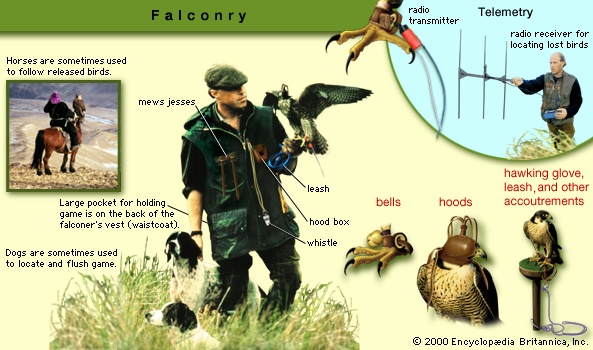 the sport of employing falcons (falcon), true hawks (hawk), and sometimes eagles (eagle) or buzzards (buzzard) in hunting game.
the sport of employing falcons (falcon), true hawks (hawk), and sometimes eagles (eagle) or buzzards (buzzard) in hunting game.History
 Falconry is an ancient sport that has been practiced since preliterate times. Stelae depicting falconry that were created by the Hittites (Hittite) date to the 13th century BC, and cave paintings from prehistoric sites may represent even earlier references to falconry. Merchants, adventurers, and Crusaders from Europe and England became familiar with falconry in the Middle East and on their return home took falcons and falconers with them. The sport flourished in western Europe and the British Isles in the Middle Ages among the privileged classes. During the 17th century, after the advent of the shotgun and after the enclosure of open lands and numerous social upheavals, falconry virtually died out, surviving in Europe largely through the enthusiasm of members of hawking clubs.
Falconry is an ancient sport that has been practiced since preliterate times. Stelae depicting falconry that were created by the Hittites (Hittite) date to the 13th century BC, and cave paintings from prehistoric sites may represent even earlier references to falconry. Merchants, adventurers, and Crusaders from Europe and England became familiar with falconry in the Middle East and on their return home took falcons and falconers with them. The sport flourished in western Europe and the British Isles in the Middle Ages among the privileged classes. During the 17th century, after the advent of the shotgun and after the enclosure of open lands and numerous social upheavals, falconry virtually died out, surviving in Europe largely through the enthusiasm of members of hawking clubs.In Great Britain the Falconers' Society of England was founded about 1770 but ceased in 1838 with the death of the then manager, Lord Berners. Because of the scarcity of herons (heron) (a main quarry of the club's peregrine falcons in East Anglia) and also partly because of the plowing up of the heathland over which the falconers rode, the centre of English falconry moved to The Netherlands, and in 1839 the Loo Hawking Club, an Anglo-Dutch society under the patronage of the crown prince (soon to become King William II) of The Netherlands, was formed. In 1853, when the royal patronage was withdrawn, the Loo Club expired. Falconry was kept alive in England by a few aristocratic amateurs and their professional falconers. Additionally, a series of clubs promoted the sport in Britain, culminating in the British Falconers' Club in 1927. The reduction of the rabbit population by myxomatosis and the placing of many of the traditional prey species on the protected list had a profound effect on the sport after World War II. All British birds of prey came under the protection of the law, and a license was required from the Home Office before a falconer could take a young hawk for falconry.
Falconry clubs exist in other European countries. The French (France) Club de Champagne went out of existence in 1870, but French falconers are organized in the Association Nationale des Fauconniers et Autoursiers Français. In Germany, the Deutscher Falkenorden (founded in 1923) is a thriving club. In the United States falconry is represented by the North American Falconers Association.
A revival of interest in the sport began in the 1970s. With the reprinting of old treatises on the art, in addition to new magazine articles and television programs on the subject, falconry began to attract new adherents.
The birds and the art
Types of birds used in falconry
Falconry is practiced worldwide, although it is considered to be a rare sport. Strongholds of the sport exist in Britain, the United States, Central Asia, and several Persian Gulf states—especially Saudi Arabia and the United Arab Emirates. The Punjab of India and Pakistan and the North-West Frontier province of Pakistan also practice falconry.
By definition, falconry is the taking of wild quarry with trained birds of prey. All diurnal (active in daytime) birds of prey are termed “hawks” in the language of falconry—whether they are falcons, hawks, or eagles—and all hunt naturally in their wild state. The skill of the falconer is to harness this natural hunting ability by training a hawk to hunt in partnership. While the nature of the sport is the same universally, there are many variations in the style of hunting emanating from the laws of the land, the different species of hawks and falcons native to a certain region, and the type of terrain available for the falconer to hunt over.
The hawks (accipiter) can be divided into three groups—longwings, shortwings, and broadwings. The hawks in each of these three categories display different traits because of adaptation to their hunting environments and prey. Longwings are falcons, such as the peregrine (peregrine falcon), the saker (Arabian Desert), and the gyrfalcon. They mainly hunt other birds in flight. Because their pursuit of quarry can take them over considerable distances, longwings are flown over open terrain, such as desert or moorland, so the falconer can keep the falcon in sight. Shortwings and broadwings take predominantly ground game, such as rabbit and hare, or bird species close to the ground, such as a pheasant breaking cover. Physically structured to work in enclosed, wooded countryside, shortwings—which are the true hawks such as goshawks or sparrowhawks—usually hunt from trees, or directly from the gloved fist of the falconer. Finally, the broadwinged group includes eagles and buzzards (buzzard). The broad wing-bases enable them to soar and they are best suited to hunting in rolling countryside and mountainous terrain, although buzzards can also hunt in wooded areas.
In some countries falconers may legally trap wild hawks, while in others only hawks bred in captivity may be used. In Britain licenses to take hawks from the wild were issued up until the 1980s, but, when sufficient numbers of hawks were domestically produced to meet the demand of falconers, the British government ceased to issue these licenses. In the United States hawks may still be taken from the wild under permit. A system of grading for falconers exists in the United States whereby a novice falconer is apprenticed to a more experienced general or master falconer for a period of two years. The only type of hawk that apprentices in the United States are permitted to train is a wild hawk that was trapped during its first year (before it entered the breeding stock of the species). Apprentices are not, however, allowed to take a young hawk from the nest or to purchase one bred in captivity, because if a hawk acquired from these sources is lost before its training has been completed, it will be unable to hunt for itself. General falconers (with two or more years of experience) and master falconers (seven or more years) in the United States can acquire permits to take wild hawks from the nest, or they may buy a captive-bred hawk. Other parts of the world regulate the taking of wild birds of prey according to the rarity of the species concerned and, in some cases, the experience or credentials of the falconer.
Hawks were first bred in captivity in some number by falconers in the late 1960s and early 1970s in Britain, the United States, and Germany. This occurred in response to a dramatic decline in the numbers of some species of wild hawks—especially the peregrine falcon—caused by pesticides such as DDT that made their way into the food chain and thinned the eggshells of wild birds, which thereby caused the eggs to fail. The availability of domestically produced hawks changed the face of falconry in many countries, as nonindigenous species became available to falconers through a commercial trade in captive-bred hawks.
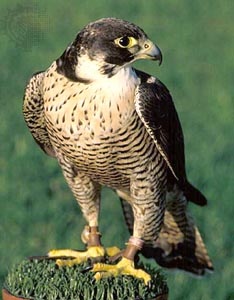 Captive-bred hawks reared by their parents in aviaries are no easier to train than wild-taken hawks, as the taming process necessary to overcome the hawk's natural wariness of humans is the same. Some species of hawks are by temperament easier to train than others. The most popular hawk used in falconry in Britain is the Harris' hawk, which is native to Central and South America, as well as to the Southwest of the United States. It is widely bred in captivity in the United Kingdom and has a placid temperament, which makes its training comparatively straightforward. The traditional hawks employed in the sport worldwide are peregrine falcons, goshawks, and sparrowhawks; while these species are unsuitable for novices, they are still the most commonly flown throughout the world by experienced falconers.
Captive-bred hawks reared by their parents in aviaries are no easier to train than wild-taken hawks, as the taming process necessary to overcome the hawk's natural wariness of humans is the same. Some species of hawks are by temperament easier to train than others. The most popular hawk used in falconry in Britain is the Harris' hawk, which is native to Central and South America, as well as to the Southwest of the United States. It is widely bred in captivity in the United Kingdom and has a placid temperament, which makes its training comparatively straightforward. The traditional hawks employed in the sport worldwide are peregrine falcons, goshawks, and sparrowhawks; while these species are unsuitable for novices, they are still the most commonly flown throughout the world by experienced falconers.Terms and equipment
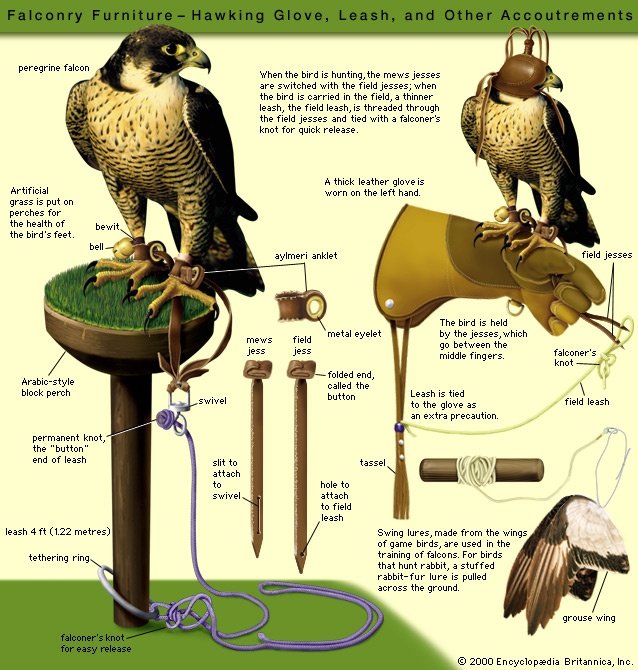
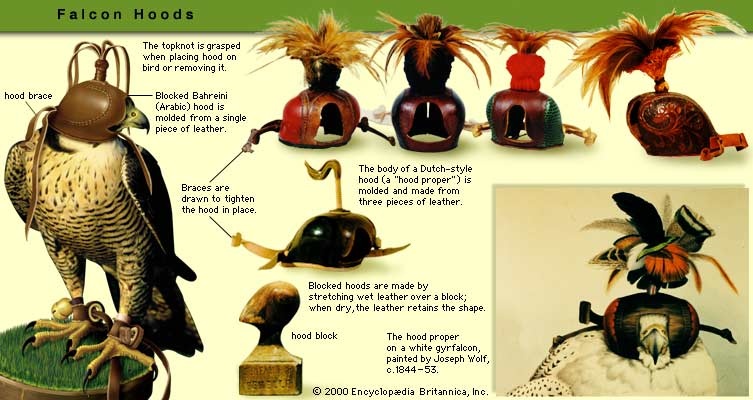 Falconry has its own language, much of which is universal. A young hawk taken from a nest in the wild or bred in captivity is known as an eyas. A hawk trapped during its first year in the wild is called a passager, and a hawk trapped in its adult plumage is termed a haggard. The female peregrine falcon is properly called a falcon, and the male—which, in common with most species of raptors, is smaller than the female—is known as a tiercel. Indoor housing for hawks is called a mews. The falconer's equipment is known as items of furniture. Examples include leather gloves, worn to protect the falconer from the hawk's talons, and hoods, used to cover the eyes of the hawk. (Longwings are trained to take, or wear, a hood from the outset of training because their quarry includes other birds in flight and, if a trained longwing is carried bareheaded, it can see other birds passing overhead at any time and waste energy attempting to leave the fist of the falconer in order to pursue them. Some falconers also prefer to train their shortwings and broadwings to take a hood for the convenience of being able to blindfold the hawk in an environment where it might otherwise be nervous.) Jesses are leather straps of equal length, fastened around the legs of a hawk to enable the falconer to retain it on the gloved fist. These straps allow for control of the hawk before it is fully trained or away from the hunting ground by permitting the falconer to choose when the hawk is to be released—for example, when suitable quarry has been sighted—and when it is to stay on the glove.
Falconry has its own language, much of which is universal. A young hawk taken from a nest in the wild or bred in captivity is known as an eyas. A hawk trapped during its first year in the wild is called a passager, and a hawk trapped in its adult plumage is termed a haggard. The female peregrine falcon is properly called a falcon, and the male—which, in common with most species of raptors, is smaller than the female—is known as a tiercel. Indoor housing for hawks is called a mews. The falconer's equipment is known as items of furniture. Examples include leather gloves, worn to protect the falconer from the hawk's talons, and hoods, used to cover the eyes of the hawk. (Longwings are trained to take, or wear, a hood from the outset of training because their quarry includes other birds in flight and, if a trained longwing is carried bareheaded, it can see other birds passing overhead at any time and waste energy attempting to leave the fist of the falconer in order to pursue them. Some falconers also prefer to train their shortwings and broadwings to take a hood for the convenience of being able to blindfold the hawk in an environment where it might otherwise be nervous.) Jesses are leather straps of equal length, fastened around the legs of a hawk to enable the falconer to retain it on the gloved fist. These straps allow for control of the hawk before it is fully trained or away from the hunting ground by permitting the falconer to choose when the hawk is to be released—for example, when suitable quarry has been sighted—and when it is to stay on the glove.Hunting and training techniques
There are several different styles of hunting with a trained hawk, the majority of which have been practiced for many centuries. Longwings take prey either “out of hood,” whereby the hood is removed and the falcon flies in direct pursuit from the falconer's gloved fist straight at quarry, or they are flown in a “waiting on” style, in which the falcon climbs high above the falconer, waiting to “stoop” at game flushed beneath it. Shortwings are natural sprinters and fly from the fist or from a tree in an accelerated burst of speed to close in rapidly on their quarry. Broadwings also fly directly from the fist (or tree) at game, but some, especially eagles, may be trained to soar while the falconer walks beneath them searching for quarry.
Falconers control trained hawks in flight with a combination of visual or oral signals—for example, walking in the direction they wish the hawk to follow or whistling—so it is important that the trained hawk remain in sight, even if it is high and distant, and preferable that it be in close enough proximity to hear a shout or a whistle. So essential is this communication between falconer and bird that the image of the falconer losing control is used in W.B.Yeats's “Second Coming” as a symbol of chaos and anarchy:
Turning and turning in the widening gyre
The falcon cannot hear the falconer;
Things fall apart; the centre cannot hold….
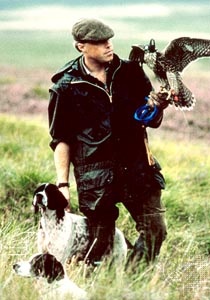
 Styles of direct-pursuit hawking with longwings include rook hawking, crow hawking, and houbara hawking—i.e., the hunting of bustard in which Arabs use four-wheel-drive vehicles to follow their prey-pursuing falcons across the desert. An example of a “waiting-on” flight is “game hawking,” in which the prey are game birds such as grouse, pheasant, or partridge and trained falcons are flown over hunting dogs that point to indicate where game is lying in cover. Shortwings and broadwings, depending on their size, are flown at prey ranging from small birds to large mammals. In areas of Central Asia such as Kazakhstan, Kyrgyzstan, and Mongolia, golden eagles (golden eagle) are flown at wolves, foxes, and gazelles.
Styles of direct-pursuit hawking with longwings include rook hawking, crow hawking, and houbara hawking—i.e., the hunting of bustard in which Arabs use four-wheel-drive vehicles to follow their prey-pursuing falcons across the desert. An example of a “waiting-on” flight is “game hawking,” in which the prey are game birds such as grouse, pheasant, or partridge and trained falcons are flown over hunting dogs that point to indicate where game is lying in cover. Shortwings and broadwings, depending on their size, are flown at prey ranging from small birds to large mammals. In areas of Central Asia such as Kazakhstan, Kyrgyzstan, and Mongolia, golden eagles (golden eagle) are flown at wolves, foxes, and gazelles.The principles of training a hawk have remained unchanged since the earliest days of the sport, a fact that can be ascertained from ancient falconry books, manuscripts dating to the 10th century, and Petruchio's comments on the “training” of a wife in Shakespeare's The Taming of the Shrew (Act 4, Scene 1):
My falcon now is sharp and passing empty;
And till she stoop she must not be full-gorged,
For then she never looks upon her lure.
Another way I have to man my haggard,
To make her come and know her keeper's call,
That is, to watch her, as we watch these kites
That bate and beat and will not be obedient.
The key to the hawk's training is in conditioning, which means finding the correct hunting, or “flying,” weight—i.e., the weight at which it would hunt if living in its natural environment—which is different for each individual hawk, and getting the hawk fit by increasing both the time it spends flying and the distances over which it is called to the falconer.
The first stage in the training of a hawk is called “manning.” This literally means taming—getting the hawk used to the falconer and its new environment. The amount of time the hawk spends in the company of the falconer—being carried on the gloved fist—is critical, but so also is the hawk's weight. An overweight hawk will be comparatively wild. Only when it recognizes the falconer and the glove as a source of food will it begin to become tamer, and this is irrespective of whether the hawk is captive-bred or taken from the wild. The falconer does not deny the hawk food but asks it to earn it, initially by the hawk feeding from the glove, then by jumping a short distance for food while tethered to the creance—a lightweight training line. As the appetite sharpens, so the hawk will fly farther for food. Shortwings and broadwings are called to the falconer's outstretched arm for food, while longwings are called to a swing lure, a pair of bird wings tied together and swung by the falconer to simulate the flying game they are being trained to hunt. The falconer keeps daily notes on the hawk's performance, its weight, and its food intake and from this can deduce the hawk's flying weight.
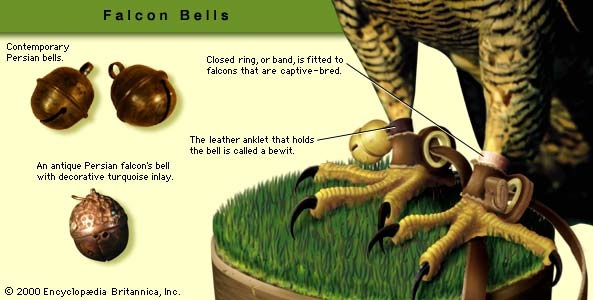
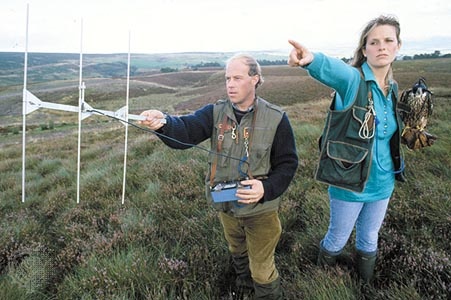 Once the hawk responds instantly when the falconer calls it for food and will chase a lure simulating the type of game it is being trained to hunt, then the creance is removed and the hawk is flown free. In the next stage the hawk is introduced to wild game in a process known as “entering.” When the hawk has achieved its first kill, the training is complete and the sport begins. By this time a bond has formed between falconer and hawk, which, combined with accurate weight control, alleviates much of the risk of losing the hawk. However, some hawks may become lost when flights at prey take them over a considerable distance and out of sight of the falconer. Small, lightweight bells attached to the legs of the hawk can help the falconer find the bird, and many falconers now attach a transmitter to a trained hawk so that it may be tracked down with a radio-receiver unit.
Once the hawk responds instantly when the falconer calls it for food and will chase a lure simulating the type of game it is being trained to hunt, then the creance is removed and the hawk is flown free. In the next stage the hawk is introduced to wild game in a process known as “entering.” When the hawk has achieved its first kill, the training is complete and the sport begins. By this time a bond has formed between falconer and hawk, which, combined with accurate weight control, alleviates much of the risk of losing the hawk. However, some hawks may become lost when flights at prey take them over a considerable distance and out of sight of the falconer. Small, lightweight bells attached to the legs of the hawk can help the falconer find the bird, and many falconers now attach a transmitter to a trained hawk so that it may be tracked down with a radio-receiver unit.Originally, falconry was a means of catching game for the table. When a trained hawk is on a kill, the falconer approaches it and holds a smaller piece of meat in his glove between the hawk's beak and the carcass. The hawk transfers its attention to the meat in the falconer's fist and steps up onto the glove, leaving the game to be transferred into the falconer's game bag and the hawk with sufficient appetite to hunt again. Although the pleasures of keeping and training a hawk have become the primary reasons for practicing falconry, game suitable for consumption is still usually eaten by the falconer.
Additional Reading
The most important early work on falconry is a remarkable and sizable volume written by Frederick II, Holy Roman emperor, The Art of Falconry, trans. and ed. by Casey A. Wood and F. Marjorie Fyfe (1943, reprinted 1969; originally published in Latin, 1596). Emma Ford, Falconry: Art and Practice, rev. ed. (1995), is a broad-based general work suitable for a beginner. Other useful titles include Phillip Glasier, Falconry and Hawking, 3rd ed. (1998); Frank Lyman Beebe and Harold Melvin Webster, North American Falconry and Hunting Hawks (1994, updated and revised printing of 1964); and Mark Allen, Falconry in Arabia (1980, reissued 1984). E.B. Michell, The Art and Practice of Hawking (1900, reissued 1967), and Jack Mavrogordato, A Hawk for the Bush, rev. ed. (1973, reprinted 1985), are regarded as classics.
- Barrackpore Mutiny
- barracuda
- barracudina
- Barragán, Luis
- Barra Mansa
- Barrancabermeja
- Barranco
- Barrande, Joachim
- Barranquilla
- Barras, Paul-François-Jean-Nicolas, vicomte de
- Barrault, Jean-Louis
- Barr, Bob
- Barre
- barre
- barrel
- barrel cactus
- Barrell, Joseph
- barrel organ
- barrel piano
- barrel vault
- Barremian Stage
- Barren Grounds
- Barre, Raymond
- Barreto, Francisco
- Barretos